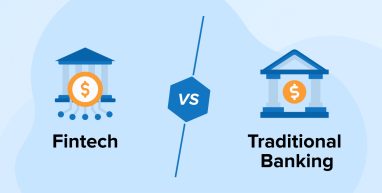
With technologies emerging every day, it has started to change the way people live and also change the way they conduct business. And one of the fields that have been affected by this change is the banking sector. It has been observing innovations that could change people’s approach toward the financial institution. For instance, mobile banking, chatbots, and 4G internet have completely changed how financial institutions perceive the customer experience and customer interaction. This proves that Fintech is a perfect way to bring in new and innovative banking facilities that can also benefit the users on a day-to-day basis. They must be able to money transfer, conduct business, and buy products with a single click without facing any issues. Just one button click is, without any doubt one of the things that have made everyone’s life easier.
Besides, now even the traditional banks started to acquire fintech startups and become digitally savvy. But to have a clear idea about fintech and traditional banks and see how different or similar they are, let’s go through this blog.
1. What is Fintech?
Fintech is a word that means “Finance” and “Technology”. It is a concept where technology helps the financial institution ease the work by creating solutions that are a combination of modern financial services and emerging technologies. Technology-based financial systems help people to avail all types of financial services without any issues. And because of this approach, the market has observed a greater increase in the use of technology for financial services than ever before. Besides, because of the mandatory and intense use of the internet, banking and financial institutions can easily track the transactions and can easily take benefit from the fintech systems.
2. What are Traditional Bank?
Traditional banks are the places that handle all the financial matters and they are licensed to get deposits from people and offer loans to businesses and individuals. There are some banks in the market that have the capability to offer other financial services like safe deposit boxes, currency exchange, and wealth management. Traditional banking has various types, for example, retail banking, investment banks, and corporate banks. And, in the majority of places, they are generally regulated by the central bank or national government.
3. Fintech vs Traditional Banking: What’s the Difference?
Some of the major differences between legacy financial institutions and those in the banking industry with a fintech ecosystem are –
3.1 Structure and Function
Fintech: Fintech is an innovative and customer-centric concept. It comes with the ability to streamline complex financial processes. And this makes it straightforward and simple for the users to access all types of banking facilities. And the financial software development companies that offer perfect fintech solutions generally use lean operating models that can determine the legacy system issues. Besides this, fintech enables organizations to make changes easier, rebuild legacy systems, and innovate the systems with something new and interesting.
In addition to this, Fintech is a concept that leverages such technologies as big data, artificial intelligence, and cloud computing to offer clients a unique & comfortable experience. And these technologies are more focused on personalization, seamless delivery, relevance, and speed. This means that fintech is the perfect solution for the banking industry as it enables streamlining of complex financial processes and makes them more accessible to people.
Traditional banks: The regulatory framework and overall financial system that traditional banks utilize restrict their ability to use emerging new technologies in time. For this reason, banks can’t come up with new products or services that can address the client’s requirements or issues at the time as fintech companies. We can say that it happens because banks are more process-oriented in comparison to fintech.
3.2 Regulations
Fintech: When it comes to fintech companies, they don’t particularly have one regulator. This is one of the most important reasons why so many fintech startups have started appearing. And without strict regulation, these fintech firms can make changes to their business and they don’t have to follow any type of strict guidelines. This makes it very simple for fintech startups to adapt to their client’s requirements and work faster in this risky industry.
Traditional Banks: The world banking system is regulated by a central or national bank in the country of origin. And the regulating bodies need a traditional bank to adhere to legal restrictions, requirements, and guidelines that can help in safeguarding the client’s money. This means that banking regulations are utilized to ensure transparency between clients and financial institutions.
3.3 Growth Potential
Fintech: On the other hand, since the pandemic, the global fintech market is rapidly growing and digital transformation has become a big deal and it is bringing up new trends every day. And this has brought some amazing growth levels in the financial market which comes with a great level of sustainability.
Traditional banks: Traditional banks have sustained the financial market for the past many years and with fintech coming into the picture and evolving in such a way, they are adapting to changes in client requirements. This also means having fintech features like mobile payments, digital security, and peer-to-peer lending which have the capabilities to enable clients to borrow money from an individual or a group of people.
3.4 Risk Factors
Fintech: As you know that fintech regulations have a flexible nature and this could make it riskier for the industry. But because of its benefits like robust, less expensive, highly user-friendly experience, and innovative nature, it is considered to be a better option than traditional banks.
Traditional banks: When it comes to legacy infrastructure, the stricter the regulations are, the more they help in lowering the risks. But if the institution wants to stay competitive, offer a better service to the users, and reach out to more people, using financial technology is very important. By offering the best services, the legacy systems can make the users come to the applications.
4. Fintech vs Traditional Banking: Comparison Table
| Characteristics | Traditional Banks | Fintech |
|---|---|---|
| Function | Banks are the institutes that are licensed to carry out financial services and focus on client security. | Fintech firms improve and automate the delivery of financial services by focusing on customer requirements. |
| Regulation | They are regulated by the national or central banks of the country. | There is no particular regulation for fintech companies. |
| Growth | Banks have limited market distribution. | Fintech companies have larger market distribution because of the new trends and technologies. |
| Risk | Strict regulations lower the risk factor. | Flexible nature makes it riskier than banks. |
5. Will Fintech Companies and Traditional Banks Work Together?
Both fintech vs traditional banking firms work as financial intermediaries. Banks have been in the business for many years, but to stay relevant in this age, they have to make radical changes to meet the modern client’s requirements. But when it comes to fintech, the users can get access to many advanced features and can get their hands on the same traditional banks’ services. And this makes the relationship between the banks and fintech firms very simple and comfortable, only if people don’t completely switch away from banks to fintech. But if banks and institutes in the fintech industry can collaborate and cooperate, they will make a great impact.
This type of collaboration can be very beneficial. Some of those advantages are –
- If fintech and traditional banks collaborate with each other, they will be regulated under similar types of legal firms which can enable the creation of trust.
- In comparison to fintech, banks have huge monetary deposits. And if they both partner, creating a perfect financial system will be very easy for any bank.
- The entire financial system can improve with the help of advanced technology that fintech brings to banking.
6. Conclusion
As seen in this blog, deciding which is better – fintech vs traditional banking is very difficult as both these systems come with some major advantages. But with the world-changing and evolving every day, and new technologies coming into the market, fintech has become the best option available in the market. It can help people use all the banking facilities from any place and at any time.






I am willing to get in the fintech sector. Unfortunately, I am an amateur with no understanding of it. But after reading this article, I feel quite knowledgeable. Now I understand actually what is fintech. Keep writing more!
Right, financial technology is a blessing for the financial industry. The adoption of the different-different technology in the finance industry is a more suitable, cost-effective, smart solution, enhanced customer experience, and many more. And I think fintech has reshaped the banking industry to the next level and will give better customer experience, quick solutions, protected and easier banking experience.
Thanks for sharing such great information. I highly appreciate your knowledge and insights that you have shared through this piece of article. Using financial technology in the banking sector is very useful for customers, businesses, and of course banks. Banks can now provide smart solutions, and enhanced customer experience using Fintech applications.